Reduce the pressure in the fuel system if the engine has just been stopped
Disconnect the wire from the "negative" terminal of the battery.
Remove the receiver.
Loosen the clamps and disconnect the fuel supply hose 1 from the fuel line 3 of the engine.
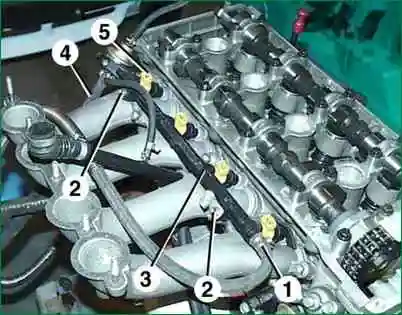
Disconnect the fuel drain hose 4 from the pressure reducing valve.
Disconnect the pads with wires from the connectors 5 of the four injectors.
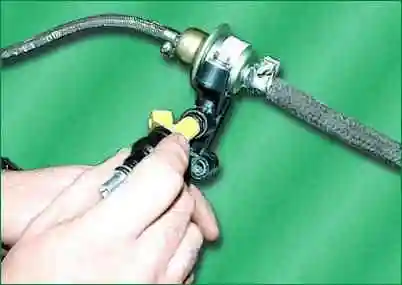
Remove the injector from the engine fuel line. The injector is fixed in the fuel line opening only with the help of a sealing ring.
Unscrew the two fastening bolts 2 and carefully remove the fuel line 3 of the engine, removing the nozzles from the holes in the intake pipe.
Injectors are fixed in the intake pipe holes only with O-rings.
Install the new injector in reverse order.
Checking the injectors
To check the tightness of the injector valve, lower the nozzle of the 1st injector into a container with gasoline or kerosene and apply compressed air at a pressure of 0.3 MPa (~3 kgf/cm 2).
If air bubbles come out of the nozzle atomizer, then the nozzle valve is leaky and the nozzle needs to be replaced.
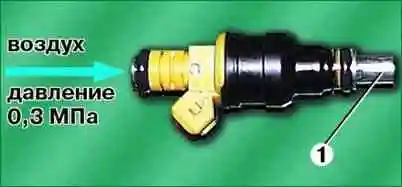
To check the health of the injector solenoid winding, apply 12 V DC to the injector connector.
In this case, a characteristic click should be clearly audible, which indicates the opening of the nozzle valve. If this does not happen, then the nozzle is faulty and must be replaced.
This test can be carried out without removing the nozzle from the vehicle.
The resistance of the injector solenoid winding can be checked with an ohmmeter by connecting it to the injector connector pins.
Resistance should be between 15.5-16 ohms. If the resistance value does not fall within the specified limits, replace the nozzle.
Checking the injector without removing it from the engine
To check the health of the injector, turn off the ignition and remove the negative terminal of the battery.
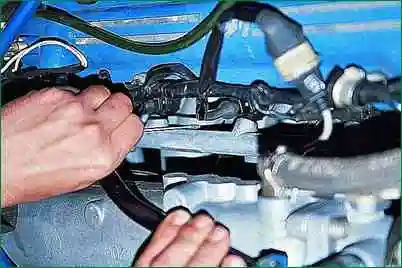
With an awl or a thin screwdriver, snapping off the spring clip of the shoe
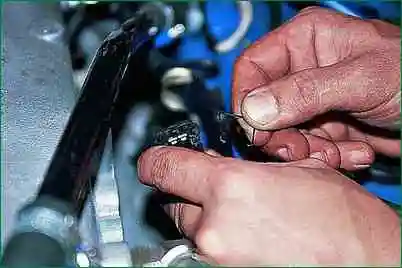
Disconnect the connector from the injector.
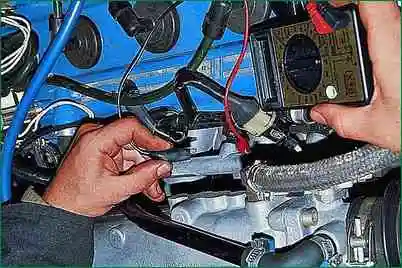
Having connected an ohmmeter to the injector terminals, we measure the resistance of the winding

The winding of a working injector should have a resistance of 15–16 ohms between the central and side pins of the connector
Further tests are carried out on the nozzle removed from the engine.
Removing the nozzle
Relieve the fuel pressure in the fuel system.
Turn off the ignition and remove the "negative" terminal of the battery.
Disconnect the idle speed controller connector.
Remove the inlet air duct and the air damper cable from the throttle pipe (see Replacing the ZMZ-406 pressure reducing valve).

Use a screwdriver to loosen the clamp of the lower (outlet) hose of the idle speed regulator.
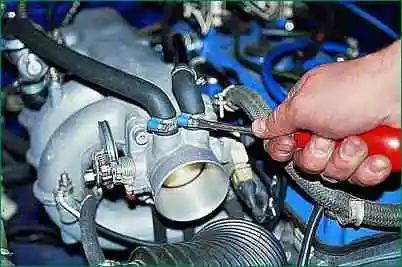
We loosen the clamp with a screwdriver, remove the hose of the crankcase ventilation system.

We loosen the clamp with a screwdriver, remove the hose of the vacuum brake booster.
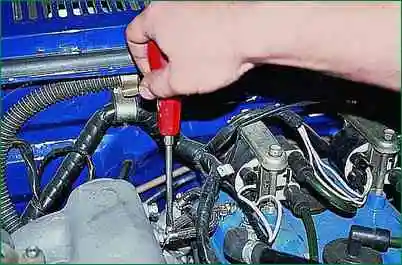
Loosen the clamp with a screwdriver, remove the fuel pressure regulator hose.
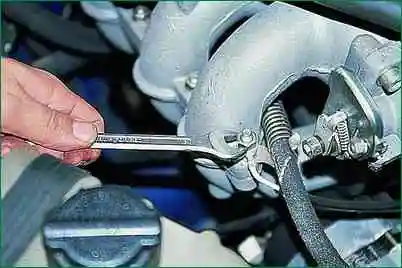
Using a 13 key, unscrew the nut that secures the ground wire tip to the first intake manifold stud.
Similarly, disconnect the wire from the last intake manifold stud.
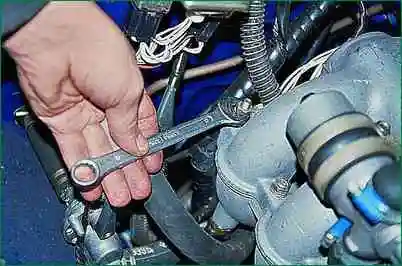
Then, having unscrewed the remaining nuts of the intake manifold studs with a wrench by 13, remove the receiver

Loosen the clamp with a screwdriver

Remove the supply hose from the fitting of the fuel rail.

We loosen the clamp with a screwdriver, remove the crankcase ventilation hose from the idling system pipe.

Loosen the clamp with a screwdriver, remove the drain hose from the fitting of the fuel pressure regulator.
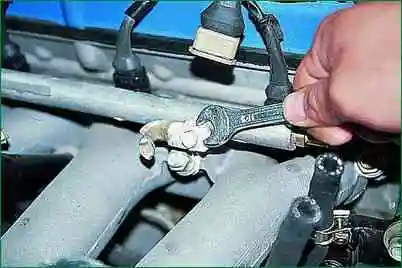
Using a 10 key, we unscrew the two screws securing the fuel rail to the intake manifold and remove the rail
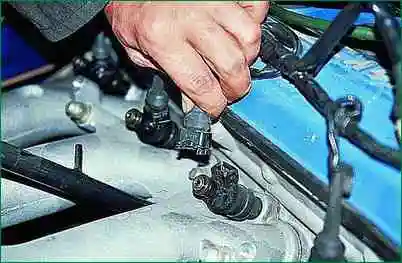
Prying off the spring latch of the block with an awl, disconnect the connector from the nozzle
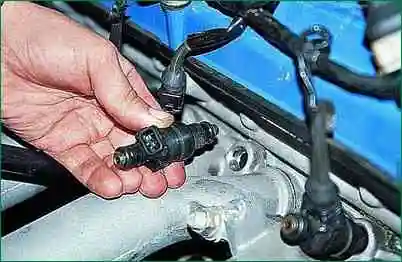
Remove the nozzle from the manifold
Install the nozzle in reverse order
Checking the injector removed from the engine
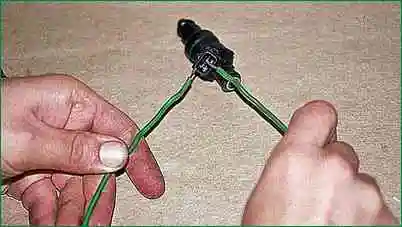
When the battery voltage is applied briefly, a distinct click should be heard.
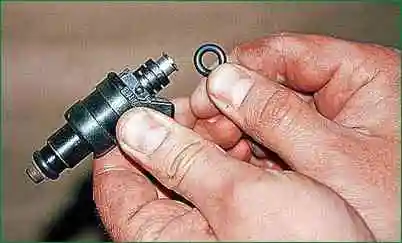
Remove the sealing collar from the nozzle flange and connect the nozzle with a rubber hose with a clamp to a source of compressed air (a compressor with a pressure gauge or a foot pump).
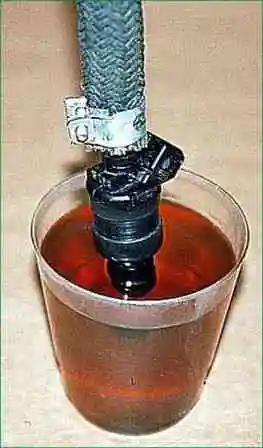
Having lowered the nozzle sprayer into kerosene, we supply air at a pressure of 3 kgf / cm 2.
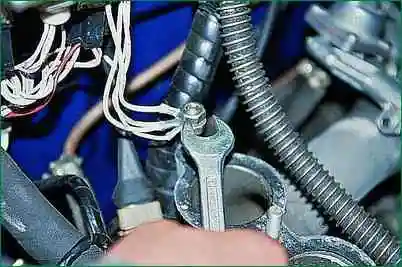
For a working nozzle, air should not pass through the atomizer.
Checking the quality of atomization with a fuel injector, for which:
We connect the ground wires that were removed from the intake manifold studs during the removal of the injectors.
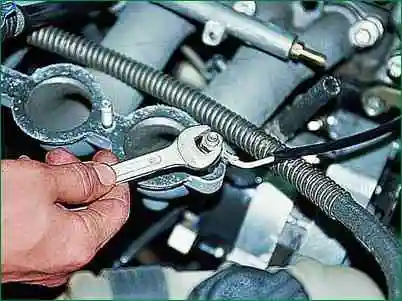
By tightening the nuts with a 13 wrench, we ensure reliable contact with the ground
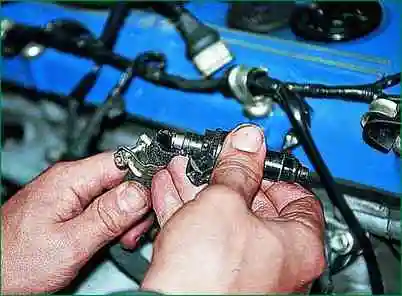
We put the inlet hose of the fuel rail on the nozzle flange and tighten the clamp with a screwdriver
We connect two wires with a length of at least 1 meter to the injector terminals.
After making sure that the ignition is off, we connect the "negative" terminal of the battery.
Turn on the ignition and, after waiting for the fuel pump to stop working, turn off the ignition.
Having fixed the nozzle over the container, we connect the wires to the battery terminals for a short time.

The nozzle should produce a conical jet of finely atomized fuel.
If the nozzle does not work, reverse the polarity of the wires.
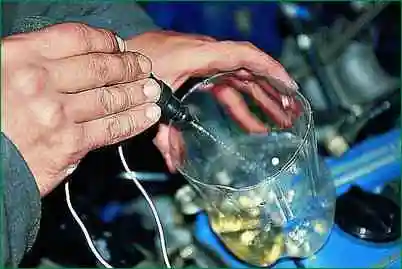
Relieve the pressure in the fuel line by applying voltage to the injector. Drain gasoline into a suitable container
We replace the defective nozzle.
Install all parts in reverse order.





